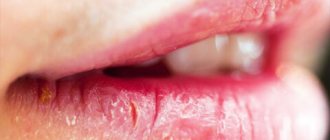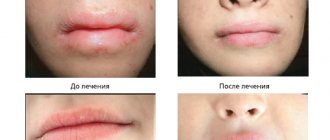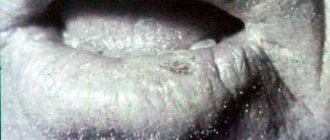01 June 2020
Cheilitis is an inflammatory process that affects the border, mucous membrane and skin of the lips. The disease has a long-term recurrent nature.
Cheilitis is an inflammatory process that affects the border, mucous membrane and skin of the lips. The disease has a long-term recurrent nature. In young people, the course is more favorable and self-healing is possible. In old age there is a risk of leukoplakia and malignancy.
Symptoms of cheilitis
The disease manifests itself in a variety of symptoms; common complaints include swelling, redness, peeling of the lips, the appearance of bleeding ulcers, purulent crusts, burning and pain when opening the mouth and eating.
There are several forms of this pathology:
- Catarrhal
- Glandular
- Exfoliative
- Eczematous
- Candida
- Allergic
The causes of catarrhal cheilitis are usually injuries, weather conditions, and chemical damage. This form of the disease manifests itself in the form of diffuse inflammation of the lips, swelling, redness, and peeling.
With glandular cheilitis, the mucous glands of the lips become inflamed. The disease can occur against the background of injuries with the addition of infection. The presence of bad habits can also contribute to the development of this form of cheilitis.
The disease manifests itself as enlarged glands, discharge of pus, and increased lip volume. Often, as a result of such an inflammatory process, the lips do not restore their previous shape, since changes in the form of cysts form in the labial glands.
Exfoliative cheilitis is divided into dry and exudative. Exfoliative cheilitis is more common in women. With dry exfoliative cheilitis, yellow scales appear on the lips and dryness is pronounced. In addition, the red border of the lips is affected by dyskeratosis.
The exudative form of exfoliative cheilitis is characterized by severe pain, swelling of the lip, and the presence of abundant crusts that make speech and eating difficult. Sometimes the crusts hang down in the form of an apron when the exudative phenomena are significant. Candidal cheilitis is provoked by the fungal infection Candida albicans, and this form of the disease is often combined with stomatitis.
Various allergens can cause another form of cheilitis - eczematous. This type of cheilitis occurs when there is an allergy to cosmetics, a lack of B vitamins in the body, or chronic injury to the lips. In addition, allergic (eczematous) cheilitis occurs due to increased sensitivity of the red border of the lips to chemicals (for example, dyes) included in toothpaste, lipstick, and dentures. It occurs with swelling and redness of the red border of the lips, then becomes covered with abundant scales and crusts, and painful cracks form in places.
Causes of cheilitis
Exposure to adverse weather conditions.
The disease often develops as a result of exposure to unfavorable climatic factors, which include ultraviolet radiation, too low or high air temperature. For this reason, cheilitis often affects people whose work involves regular exposure to fresh air.
Development of an allergic reaction.
One of the reasons for the development of cheilitis is an increase in the sensitivity of the lips to various irritants, mainly of chemical origin.
In this case, the area of the red border of the lips is most often affected and, less often, the mucous membrane. If you do not consult a doctor in a timely manner and do not undergo treatment, the disease can spread to the skin surrounding the lips. Most often, the disease develops due to the use of lipsticks. This is explained by the fact that their composition includes the dye eosin and specific fluorescent substances. The plastic of dentures, aromatic fillers included in toothpastes, etc. can also act as irritants. The disease mainly affects women aged 20-60 years.
Presence of an underlying disease.
Cheilitis on the lips can be a symptom of some disease and manifest itself against the background of neurodermatitis or atopic dermatitis. Eczematous cheilitis is formed with various eczemas, macrocheilitis - with neuritis of the facial nerve in combination with a folded tongue. The most common cause of the disease is dermatoses. The skin of the lips, mucous membrane and red border can also become inflamed with systemic and infectious diseases (psoriasis, tuberculosis, lichen planus, erythematoses, etc.).
Up to contents
Prevention
As you know, prevention is cheaper than treatment. In addition, preventing a disease is much easier than curing it, although this will require regularly following some rules.
Pay more attention to oral hygiene. To prevent the formation of cracks, it is necessary to protect the skin and mucous membranes of the mouth from adverse effects: unlearn the habit of licking the lips and corners of the mouth, use medicinal cosmetics for dry skin (lipstick, balm, cream). To avoid infection of the skin of the lips from the oral cavity, it is necessary to regularly brush your teeth, see a dentist, and promptly treat caries and inflammatory gum diseases.
Follow the rules of nutrition. If cracks appear in the corners of the mouth, exclude from the diet spicy, sour and salty foods that irritate the mucous membrane and skin. Include less acidic fruits and vegetables in your daily diet, as well as foods containing iron and riboflavin (beef, liver, dairy products, cabbage, potatoes, peanuts, almonds and others).
Give up bad habits. Smoking is a provoking factor in the development of this disease.
Kinds
1. Angular . It is most common among women and is also diagnosed in children and the elderly. With it, the oral mucosa can be affected on one or both sides. Patients complain of pain when talking, laughing, and chewing food. Such cheilitis occurs from constant irritation of the corners of the mouth or their infection, with allergies, deficiency of microelements and vitamins, and excessive salivation. As a result, erythematous (reddened) and dense whitened areas form above the upper and (or) lower lip, they become covered with cracks and bleed moderately.
2. Exfoliative . It mainly affects females in adulthood (30-45 years), the main complaint is pain when closing the mouth. It can occur in an exudative form (in which foci of inflammation with pathological fluid form under the yellowish crusts on the lips), and it happens that such cheilitis takes on a dry form with the formation of difficult-to-remove scales around the mouth.
3. Glandular . It is rare and occurs mainly in men aged 30-40 years. It most often affects the lower lip and occurs in three ways:
- serous, with accumulation of effusion in the subcutaneous layer of the mucosa and hypertrophy of the sebaceous glands, because of this its surface becomes lumpy, crusts appear, and from under them - discharge;
- purulent, with the formation of a cloudy and thick effusion and its flow out, the crusts on the lips are dense and dark in color;
- fibrous, which is characterized by the closure of the sebaceous and sweat ducts of the skin by connective fibers, because of this, the formation of subcutaneous cysts begins and the lip turns outward.
4. Abrasive (pre-cancerous) or otherwise - Manganotti cheilitis. A serious disease with a tendency to malignancy. It is based on atypical changes in skin cells, disruption of their nutrition and maturation mechanism. It manifests itself in the formation of persistent and untreatable erosions without crusts with moderate pain and bleeding.
5. Atopic . This is a disease of the dermis, which is caused by its irritation under the influence of environmental factors or metabolic disorders in the body. It is expressed by dryness of the mucous membrane of the lips, its peeling and thinning.
6. Allergic . It is a consequence of intolerance to certain substances (food, cosmetics, drugs). It is characterized by the formation of bursting blisters with clear liquid, severe swelling and itching of the lips.
7. Meteorological (actenic). It occurs in response to natural factors (sun, wind, water), and occurs in a dry or exudative manner.
8. Macrocheilitis . Diagnosed with neuritis of the facial nerve, its signs are: change in the color of the lips (cyanosis) and their swelling.
9. Eczematous . It is a symptomatic sign of the general process of skin inflammation under the influence of neurogenic, infectious or allergic irritants.
10. Hypovitaminosis . Occurs as the body’s response to a lack of vitamins. A characteristic sign of this pathology is a bright red color of the lip borders combined with a burning sensation in the tongue.
11. Candidiasis . Caused by the proliferation of fungal flora on the skin. With it, traditional symptoms are combined with the formation of abundant, easily removable white or gray plaque in the corners of the lips.
Treatment of cheilitis
Treatment of the disease depends on the causes of its occurrence. For example, to treat allergic cheilitis, drugs are used that reduce the body’s sensitivity to allergens - antihistamines, as well as vitamins. Zinc ointment, anti-inflammatory creams containing glucocorticoids, salicylic acid, and sulfur are used externally. Avoid substances that irritate the mucous membrane of the mouth and lips. After eating, rinsing with chamomile infusion or soda is useful. To determine the allergen, it is necessary to conduct allergy tests.
For fungal cheilitis, antifungal drugs are prescribed in combination with vitamin B2 and ascorbic acid. An examination by a dentist and, if necessary, complete sanitation of the oral cavity and thorough treatment of problem areas with oil solutions of vitamins are recommended. To prevent relapses, a diet with limited carbohydrates is prescribed. In the treatment of exfoliative cheilitis, corticosteroid and photoprotective ointments, 2% boric salicylic acid ointment are widely used. In the presence of an exudative form of exfoliative cheilitis, Bucca radiation is effective.
Diagnosis of this disease is carried out by several doctors: a therapist, a dentist, an allergist. A combination of systemic (general) and topical (local) drug therapy produces a good effect.
Back to articles
ICD-10
In medicine, a group of diseases of the lip mucosa is designated by a special code - K13.0 .
The classification defines these pathologies as diseases of a benign nature with diverse causes of their occurrence.
The section includes a number of diseases: abscess, fistula, cellulite of the lips, their jams, cracks, hypertrophy and the main forms of cheilitis and cheilosis, which arise as independent pathologies and as a symptom of underlying diseases. Their nature can be different, both inflammatory and degenerative.
Fungal infections of the lips are excluded from this subgroup; they are classified in heading B37.83. Separately, this official document highlights cheilosis due to vitamin A hypovitaminosis (E53.0) and allergic cheilitis, included in block L20-L30.
Cheilitis on the lips: photo
Varieties of cheilitis in medicine are grouped by doctors into subgroups according to certain characteristics:
1. According to the speed and characteristics of the process (acute, chronic, latent, in the acute phase).
2. By origin: cheilitis itself (actinic, meteorological, allergic, etc.) or symptomatic (atopic; lip eczema, Melkersson-Rosenthal syndrome, etc.).
Signs, types and methods of treating cheilitis on the lips
- Causes
- Symptoms
- Kinds
- Treatment
Redness, dryness, and cracks on the lips are familiar to many. These are pronounced symptoms of cheilitis, popularly called “jams”, an inflammatory lesion of the red border and nearby areas of the skin. Almost every person in the world has experienced symptoms of cheilitis, but not everyone turns to specialists with this problem.
Doctors rarely use the term “cheilitis” to describe a specific disease; usually this word refers to an inflammatory process. However, cheilitis in any form is a disease that requires specialist consultation and appropriate treatment.
Cheilitis does not have a permanent place of residence; it can be diagnosed by almost any doctor, since there are many reasons for the appearance of the disease. But most often, dermatologists and dentists are involved in its diagnosis and treatment.
Causes
The causes of inflammation on the lips may be the following factors:
- Dysfunction of the nervous system;
- Genetic predisposition;
- Decreased immunity, allergic reactions;
- Ultraviolet irradiation;
- Exposure to extreme weather factors - cold, wind, dry air;
- The presence of chronic foci of infection in the oral cavity, such as caries, pulpitis, periodontitis;
- Traumatic damage to the red border.1
Symptoms
The picture of the disease depends on the type of inflammatory process and its causes. Common symptoms include:
- Redness and swelling of the red border of the lips;
- Excessive thickening of the skin;
- Pain in the area of inflammation, especially during eating;
- Dry skin and the formation of cracks and erosions on it;
- A sharp change in the color of the damaged mucous membrane.
Types of cheilitis
According to the modern classification of cheilitis, diseases include two main groups: independent inflammatory processes (granular, allergic, meteorological, contact, etc.) and symptomatic lesions (eczematous, atopic and others). The division into such types is based on the causes and characteristics of the clinical course of the disease2.
Glandular cheilitis
The disease is characterized by an inflammatory process in the small salivary glands located on the border of the red border of the lips. The inflammatory process is located in the area of the lower lip. This disease is a consequence of the abnormal structure of the lower lip. The disease has a characteristic clinical picture and begins with the appearance of bright red dots filled with saliva on the mucous membrane of the lips and red border. Even if you blot your lips, droplets of saliva appear again after a while.
Glandular cheilitis includes three subtypes:
- Simple, in which the lower lip is slightly enlarged in size, and small nodules covered with saliva are visible on the mucous membrane.
- Secondary, which develops due to chronic diseases (systemic lupus erythematosus, rheumatoid arthritis, etc.).
- Purulent - a rare type, which is characterized by infection of the ducts of the salivary glands with subsequent release of pus.
Glandular cheilitis is treated with antibacterial agents, corticosteroid ointments and drugs to simulate epithelialization. Doctors additionally prescribe the patient vitamins A and B. If conservative treatment is unsuccessful, dentists resort to plastic surgery3.
Atopic cheilitis
This pathological condition is a separate manifestation of dermatitis, neurodermatitis and mainly affects people aged 7-17 years. A key risk factor is a genetic predisposition to an allergic reaction.
Symptoms of the atopic type are itching, redness, and slight swelling of the red border in the corners of the mouth. Often this inflammatory process spreads to the skin. The patient gradually develops dryness, cracks and crusts at the site of scratching. As the acute phase subsides, increased peeling of the skin of the lips is observed, and small cracks form in the corners of the mouth.
Treatment of the atopic form consists of systemic administration of antihistamines, vitamins, sedatives, and local treatment with corticosteroid ointments.
Macrocheilitis
The disease refers to pathologies associated with impaired lymph outflow. A symptom of macrocheilitis is painless lip enlargement. The disease occurs in a chronic form, with constant alternation of stages of exacerbation and remission. Diagnosis is made by visual confirmation of edema and fibrous inflammation.
Treatment of macrocheilitis in the early stages is medicinal and therapeutic. Doctors recommend the patient thermal baths, massaging the damaged area of the red border, paraffin therapy, sclerosing therapy. When the disease develops, experts advise radical intervention.
Meteorological cheilitis
Adverse weather conditions can cause inflammatory lesions of the red border. Symptoms of the meteorological type are infiltration and hyperemia of the lips. In this case, the outer layer becomes covered with scales, and increased dryness of the red border is noted. Patients complain of dryness, a feeling of “tightness” of the lips, and increased peeling.
Treatment of the meteorological form is aimed at eliminating the effect of the irritating factor. In such cases, experts advise taking nicotinic acid and B vitamins. Local treatment is carried out with hygienic lipstick and photoprotective cream.
Exfoliative cheilitis
This is an isolated disease of the red border, manifested by peeling of the epithelium and disruption of its keratinization processes. The main factors are genetic predisposition and lack of immunity.
Symptoms of the exfoliative type depend on the clinical form of the disease:
- 1 The dry type of inflammation is characterized by the formation of a thin strip of scales between the red border and the mucous membrane. After their removal, the hyperemic surface of the lip is exposed, which is soon re-covered with the same scales. These cycles can repeat for decades.
- 2 In the exudative form, patients complain of a layer of yellow-brown crusts in the area of the lower lip. After removing such growths, a bright red surface covered with white exudate is noticeable. In such cases, the crusts tend to be constantly restored, which causes the cyclical nature of the pathology.
Treatment of exfoliative cheilitis in the dry form involves lubrication with moisturizing ointments, lipsticks, and at the exudative stage, patients undergo complex therapy using immunostimulants.
Actinic cheilitis
Chronic inflammation of the skin of the lips, which forms due to exposure to ultraviolet rays, develops mainly in spring and summer.
Actinic type symptoms are determined depending on the form of the disease:
- 1 The dry stage is manifested by a swollen red border covered with whitish scales.
- 2 With the exudative form, bubbles appear, which, when cracking, form cracks and erosions.
Treatment of such cheilitis consists of protecting the lips from direct sunlight, moisturizing the surface of the lips and treating it with products with protective UV filters. In severe cases, specialists resort to the use of corticosteroid ointments.
Eczematous cheilitis
Chronic allergic inflammation can occur on its own or be a symptom of facial eczema. Allergens can be different - germs, cosmetics, medications, certain foods, toothpaste and much more.
The symptoms of such cheilitis are very diverse. First, bubbles appear against the background of a bright red lip. These elements gradually merge, crack, and become wet. Over time, the surface becomes covered with scales. Patients are bothered by itching, burning, difficulty speaking and opening their mouth.
Treatment is carried out at two levels: systemic (antihistamines and vitamin preparations) and local (corticosteroid cream and antiseptics).
Contact allergic cheilitis
The disease occurs after frequent contact of the skin of the lips with chemicals that cause an allergic reaction. Swelling of the lips can spread to the mucous membrane and skin. After some time, individual areas of peeling, blisters, and erosions are noticeable.
Treatment of the contact allergic form involves eliminating contact with the chemical factor. Patients also use corticosteroid ointments and systemic antihistamines.
Chronic cracked lip
Inflammation of the deep layers of the skin of the lips provokes the formation of cracks. The causes of the disease may be climate change or trauma to the red border.
Treatment of cracks is carried out after identifying the cause of the damage. Local hormonal ointments, painkillers and agents for restoring the mucous membrane are used.
Hypovitaminous cheilitis
The main reason for this inflammation is insufficient intake of vitamins A, E, B into the body. Symptoms include chronic fissure, burning sensation and dryness in the red border area.
Treatment includes taking vitamin preparations and local treatment of the inflammation with antiseptics3.
How to treat cheilitis on the lips?
Treatment of cheilitis depends on the type and extent of the disease. In most cases, therapy is complex. At the systemic level, doctors recommend getting rid of the causative factor, prescribing antibacterial medications and immunostimulants.
Local manifestations are treated with hormonal ointments and antiseptics. During recovery, it is advisable to lubricate your lips with a drug that stimulates the immune system.
With reduced local immunity, inflammation often occurs not only on the lips, but also in the oral cavity and its mucous membranes. The drug Imudon® will help strengthen local immunity. This is a local drug for the treatment and prevention of infectious and inflammatory diseases of the oral cavity and pharynx4. Imudon® interacts with the mucous membrane directly at the site of the disease, providing protection against bacterial, fungal and viral pathogens. Lactobacilli contained in the drug relieve inflammation and promote healing and restoration of the oral mucosa5.
Treatment of cheilitis on the lips in children is carried out by a pediatric dentist or dermatologist using broad-spectrum antibacterial medications and natural-based restoratives.
The article was prepared based on materials:
1. Lutskaya I.K. Diseases of the lips - cheilitis / I.K. Lutskaya // Consilium Medicum. Dermatology (Add.). – 2016. – No. 1. – 58-62 s. 2. Borovsky E. V. Diseases of the mucous membrane of the mouth and lips. / E. V. Borovsky, A. L. Mashkilleyson. – M.: Medicine, 1984. – 116-129 p. 3. Lutskaya I.K. Clinical manifestations of independent lip diseases / I.K. Lutskaya // Medical news. – 2011 – No. 11. – 4-8 s. 4. INSTRUCTIONS FOR MEDICAL USE OF THE MEDICINE Imudon® dated 07/02/2018. 5. Shumsky A.V. Imudon in the treatment of infectious and inflammatory diseases of the oral mucosa. Scientific and practical journal “Dentistry”, 2000, No. 6, volume 79, p. 53-54.
The material was developed with the support of Abbott to improve patient health awareness. The information in the material does not replace the advice of a healthcare professional. Contact your doctor.
RUIMD192468 from 08/16/2019
To learn more
How to treat cheilitis on the lips?
To identify the disease and determine its cause and type diagnosis ; the clinic usually carries out:
- skin tests and smears;
- Ultrasound of internal organs (thyroid, pancreas, liver, etc.);
- blood tests (general, biochemistry, antibodies, allergens, etc.) and urine;
- biopsy and histology of epithelial cells.
Treatment is selected according to the diagnosis:
1. General strengthening measures:
- systematic oral and facial hygiene;
- sanitation of the lip mucosa with aseptic solutions;
- getting rid of irritants (nicotine, alcoholic beverages, the habit of biting or licking lips, hypersalivation, contact with allergens, solar radiation, etc.);
2. Drug therapy
- local treatment, antibacterial or glucocorticosteroid ointment (as indicated);
- taking antihistamines;
- pain relief for severe pain;
- a course of antibiotics, antiviral, immunostimulating agents (depending on the type of cheilitis).
3. Physiotherapy:
- ultrasound;
- UHF;
- electrophoresis.
4. Surgical treatment:
- electrocoagulation;
- laser cauterization;
- cryodestruction.
Drugs
Medicines traditionally used in the treatment of cheilitis:
- Prednisolone;
- Erythromycin;
- Doxycycline;
- Diphenhydramine;
- Suprastin;
- Infliximab;
- Methotrexate;
- Zinc;
- Boric acid;
- vitamin A, vitamin B, PP, etc.;
- Roxithromycin;
- Peridoxin;
- Sulfasalazine;
- Kenalog 40;
- Tacrolimus-teva;
- salicylic acid;
- sulfur;
- Bromine, Valerian, Motherwort;
- Elenium, Oxilidine, Seduxen.









